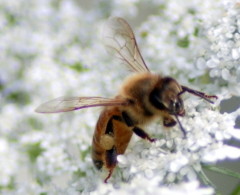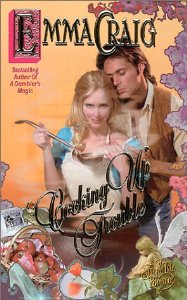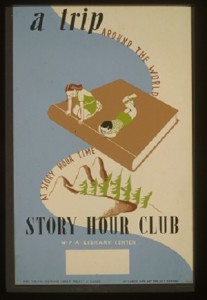Portland, Maine – Library Ukulele Jamboree
Ukuleles at the Portland Public Library
For a few weeks now I’ve been visited by a mild but annoying aberration: intermittent cerebral background music to divert my daily routine. Tiny Tim performing “Tiptoe through the Tulips” to be exact. Also an occasional faded, flickering flashback of Tim serenading Miss Vicki on Carson. (As I don’t recall viewing such a performance, broadcast or video, I assume the flashbacks originate in the severely neglected nostalgia lobe of my imagination, and not in original memory traces.)
I can date exactly the onset of these phenomena. On April 18, I read a blog post from Justin the Librarian: Community, Libraries, Ukuleles, and Love. The post describes the donation of four ukuleles to the Portland, Maine Public Library young adult collection, kicked off with a ukulele jamboree in front of the library. “Patrons can check out a bag containing a ukulele, an instructional DVD, a uke chord book, and the novel or non-fiction book the ukulele was named after.” In the words of teen specialist Justin the Librarian, aka Justin Hoenke, “This is crazy awesome…”
Teen librarians do stuff like this. It’s fun, gets teens and the community involved, and bags publicity for the library. I smiled, filed, and went on. But then Tiny Tim’s insistent falsetto kept leading me back to the four teen-novel-inspired ukuleles (Reunited, So Punk Rock, Seraphina, and So You Wanna Be a Superstar).
First one’s free
The question I kept returning to: why ukuleles? Why not saxophones, or snare drums, or keyboards, or even guitars? One answer, of course, is that the Portland ukuleles are not the insidious first step in positioning the library as a serious resource for musical instruments—they are a one-off lark. Also: ukuleles are comparatively cheap; they don’t have much of a learning curve; they come in bright colors; and though jaunty, they aren’t particularly loud, a plus for both library and home.
But I was left with a more subtle question about my immediate reaction to the post. Ukuleles seemed like a natural library fit, but I would have been taken aback to learn of a collection of four library saxophones. Why do ukuleles make library sense to me, and not saxophones? Do I really want to privilege budding Tiny Tims over budding John Coltranes?
When I went back to the post, the answer leapt out:
“Ukuleles are the entry drug to music and performance,” said Portland Public Library staffer Michael Whittaker, ”this program will allow patrons to experiment free of charge.”
The metaphor of a library as a gateway has a long and honorable history, and adding the qualification that it is a gateway (or entry) “drug” makes the analogy even more clear – especially the “experiment free of charge” part. As librarians we tend to forget that visiting a public library is just the beginning of knowledge: the hard stuff is beyond, and requires a more intense personal investment. A library is not knowledge incarnate, poised to enlighten us the moment we step into its sacred precincts. Libraries don’t contain knowledge; they contain artifacts that people use to create knowledge.
More exactly, knowledge is in people’s minds, not in artifacts like books or databases. And the transformative, seriously addictive high from knowledge comes when we creatively engage our minds with the world at large, not just with libraries, books, databases, or even librarians.
If you’re uncomfortable around gateway drugs, here’s another metaphor with roughly the same significance: libraries as a keystone species in a community’s knowledge ecology. Bonnie Nardi and Vicki O’Day devote a chapter to the notion of special librarians as a keystone species in Information Ecologies: Using Technology with Heart (1999). Their insights are just as relevant for the embedded, interactive pathways of all types of library.

This tiny honeybee (Apis mellifera) is a member of a keystone species whose gateway function as a pollinator (along with other insects) created $29 billion in U.S. agricultural value in 2010. Operating revenue of U.S. public libraries in 2010: $11.3 billion. Photo credit: Bob MacInnes via Flickr.
The phrase “keystone species” is derived from the keystone of an arch, which bears little weight but is crucial to the (gateway) function of the structure. Nardi and O’Day elaborate on three practices which explain special librarians as a keystone species. Although Nardi and O’Day limit their chapter to librarians, these practices are also characteristic of the overall function of libraries as a pivotal but often overlooked species in any knowledge ecosystem. “Information therapy”: helping the reader uncover and understand his or her own needs. “Strategic expertise”: helping the reader organize and focus his or her travels beyond the gateway. “Building relationships”: serving as an ongoing, familiar base for knowledge exploration. These functions do not explicitly require a library, let alone a librarian, but the organized portal that is a library can certainly speed you on your way.
So you wanna be a plumber/physician?
Here’s a homely public library illustration to make all this more concrete.
Phyllis the physician relaxes by cooking gourmet meals. One afternoon while preparing Carbonnade (beef and onions braised in beer), she inadvertently sends a pound of onion skins down the disposal. The drain clogs. Phyllis calls her neighbor, Plácido the plumber, who comes right over and crawls under the sink. A few minutes later he emerges with a puzzled frown. “I’m not sure what to do,” he says. “I’ll have to go down to the public library and research this.”
Or:
Plácido spends a lot of time fooling around under sinks, is a tad overweight, and jogs for half an hour every day. He develops a recurring pain in his left knee. He mentions this to Phyllis in the course of his annual physical. She takes a look, asks a couple of questions, and frowns. “I’m not sure what to do,” she says. “I’ll have to go down to the public library and research this.”
Neither scenario seems likely.
On the other hand, let’s say Phyllis doesn’t find Plácido at home when she calls about the clogged drain. We wouldn’t find it unlikely for Phyllis the physician to do a little plumbing research at the public library. Or Plácido the plumber to do a little medical research at the library before his visit to Phyllis. Plácido and Phyllis seek help from the public library at the margins of their knowledge, not the core. Consequently, and sensibly, they think of the library as a marginal knowledge resource: good to have, but not essential. A fine place to dabble, but not the destination to earn and/or polish your reputation as a physician or a plumber. An introductory gateway to unfamiliar knowledge and experience.
Of course it would be unusual for Phyllis or Plácido to bother with a trip to the library these days, at least to increase their knowledge of plumbing or medicine respectively. They would simply find something to meet their immediate marginal needs online. In the age of the Internet, what hope does the story of Phyllis and Plácido offer for the future of the public library as a gateway (drug) to knowledge?
The puzzling persistence of cookbooks
As it happens, Phyllis and Plácido share a secret passion. And another passion, the obsession that brought them together: food. Cordial neighbors, but no more, they chanced upon each other browsing the 610s at the public library, and soon found themselves on Plácido’s kitchen floor, his rugged but gentle hands…

Phyllis and Plácido posed for this cover, at least in my imagination. Note that Plácido’s midriff has been retouched.
But I digress. Let’s focus on a less personal example of the library as gateway: the continued dominance of cookbooks in public library nonfiction circulation. As a novice selector, the first truism of nonfiction I learned was that cooking is the most popular nonfiction topic. When I began running the numbers, I routinely verified that truism. Cooking (followed by health) was usually at the top of the nonfiction demand list.
Oddly enough in the age of the Internet, cooking still heads the list. I say oddly, because you might expect that competition from the huge Web cooking sector, to say nothing of the Food Network, would have reduced cooking’s print dominance at the library. But Library Journal’s February 2013 report on public library collection trends shows that cooking still leads the top-circulating nonfiction subjects (81%), followed as usual by medicine/health (58%) – the latter also subject to Internet competition, come to think of it.
What explains this persistent dominance? I hypothesize that readers use a library cookbook collection primarily as an imaginative gateway, not as an instrumental technical resource. I also hypothesize that this phenomenon is emblematic of much, if not most, adult nonfiction collection use. My evidence is subjective, derived from decades of talking with and assisting readers in public libraries. I’ll let you judge its plausibility.
The joy of cooking
In my experience, most home cooks own at least one well-worn, carefully annotated basic cookbook; have assembled or inherited a recipe box; have responded with delight to the Internet; and most importantly, have created a wealth of personal if tacit cooking knowledge through hands-on experience. These resources are the ongoing basis for home cooking decisions. I doubt if there are any cooks whose daily méthodes de travail à la cuisine include consulting a copy of The Joy of Cooking housed at the local public library. Well, maybe an occasional cheapskate librarian.
So much for Circulation, but what about Reference? Back in the day, I would answer an occasional one-off cooking question from the reference or reader’s assistance desk, but I’m reasonably certain the Web has captured the market for cooking ready reference. Need a recipe for Carbonnade? There’s an app for that, and for your menu too. Not sure how to chop an onion? Type “video chop onion” into a Google search box and get “about 6,790,000 results (0.35 seconds)”: the first five of which are, in fact, instructional videos on how to chop an onion. Forgotten how many tablespoons in a cup? Enter “tablespoons in cup” in the anonymity of your own home, without embarrassing yourself by placing a call to that nice young man at the reference desk: 16.
So what drives continued high demand for public library cookbooks? Not routine cooking practice, nor an occasional factual itch. For an explanation of cookbook demand, take a field trip to browse the new cookbooks at your public library (or better yet, at a bookstore, which will have a wider selection at hand). You will find pictures and narrative, with recipes almost an afterthought to stories of a dish and its culture, the people of that culture, and/or the author’s vicissitudes in collecting the recipe. I use culture in the strictest sense: The Deen Bros. Get Fired Up: Grilling, Tailgating, Picnicking, and More resonates with as much cultural authority as Paula Wolfert’s masterful The Cooking of Southwest France: Recipes from France’s Magnificent Rustic Cuisine.
People continue to welcome library cookbooks into their homes because they are an excellent medium for two kinds of stories:
- Imaginatively, a cookbook collection is a narrative gateway through which a reader explores cuisines, cooking styles, cultures, and the way other people live. A cookbook tells a (usually) unselfconscious story of everyday rituals and foodways, from the imagined consumer perfection of Better Homes and Gardens New Cookbook to the imagined Parisian grace of Mastering the Art of French Cooking. Many of the readers who imaginatively explore a cookbook collection actually cook, but some do not. I have spoken with readers who crave cookbooks like other readers crave novels, and avoid kitchens at every opportunity.
- Instrumentally, a cookbook collection is a resource through which practicing cooks experience and extend the narrative of their own lives, weaving foodways and rituals into the stories they tell of themselves: the accomplished gourmet researching her next knock-your-socks-off dinner party; the home cook systematically exploring/expanding his repertoire; the novice trying out how different styles and cuisines relate to her life. These cooks aren’t searching for recipes or instruction per se, they are searching for ways to creatively express themselves through one of the fundamental shared practices of world culture.
For most readers, cooks or not, library cookbook collections are a browsable treasure of fascinating, creative stories; they are not easily substituted tiers of “content” divisible into specific facts or recipes. Library cookbook collections are freely available, expansive gateways to the joy of cooking.
Sometimes, truisms are true
A public library can reasonably be described as a gateway to imaginative knowledge, not just if it offers ukuleles or cookbooks, but through all that it offers. For most people, most of the time, the “imaginative gateway” analogy captures the essence of how a public library works in people’s lives.
Taking the gateway metaphor seriously helps explain some of the unsettling phenomena librarians often blame themselves for, and/or carefully ignore:
- People do not routinely depend upon the public library for “essential” knowledge. If you do not find this intuitively obvious, I hope the story of Phyllis and Plácido helps make it clear.
- The public library is a “marginal” institution in most people’s lives. That doesn’t mean it’s unimportant or underappreciated. Gaining knowledge at the margins is critical to learning, and people gravitate to it as they sense the need. But it is still knowledge at the margins: exploratory, apt to wander, and valuable precisely because little is at risk.
- The underlying transformative power of a library lies in encouraging imaginative play, not providing commoditized units of “information.”
- Concomitantly, public library use is overwhelmingly focused on works of narrative, not exposition, because that’s how imagination functions. This focus is apparent over the entire collection, including adult nonfiction, and extends to programming and other services as well.
Librarians want nothing more than to be taken seriously. We despair that we are branded as the place for “books,” forgetful of the power and affordances of “books” in people’s lives. We focus our attention and our public rhetoric on the public library as a critical “information” resource, while all those imaginative cookbooks, novels, DVDs, picture books, et. al. are passed over as entertaining but embarrassing extras. But in practice the reverse is at least as true. The imaginative stuff is at the core of how most people, most of the time, view public libraries and use their services. The instrumental stuff, while necessary to the library’s mission, for the most part goes begging. The library as imaginative gateway is not an empty slogan.
My advice is to pick up your old ukulele and strum, strum, strum.
Links, citations and asides
- I read a blog post: Justin Hoenke. Justin the Librarian (April 9, 2013). “Community, Libraries, Ukuleles, and Love.”
- The four teen-novel-inspired ukuleles: Reunited, So Punk Rock, Seraphina, and So You Wanna Be a Superstar.
- Bonnie A. Nardi and Vicki L. O’Day (1999). Information Ecologies: Using Technology with Heart.
- $29 billion in US agricultural value annually: Cornell Chronicle (May 22, 2012), “Insect pollinators contribute $29 billion to U.S. farm income.”
- Operating revenue of U.S. public libraries: IMLS (January 2013). Public Libraries in the United States Survey, p. 19.
- Report on public library collection trends: Barbara Hoffert. Library Journal (February 19, 2013). “Materials Mix: Investigating Trends in Materials Budgets and Circulation”.
- Irma S. Rombauer and Marion Rombauer Becker (revised 1975). Joy of Cooking. Stay clear of later editions; they’ve had most of the joy revised out of them.
- There’s an app for that: New York Times (August 29, 2012). “APP SMART: A Shelf Full of Cookbooks at Your Fingertips.”
- For your menu too: parentingSQUAD (July 8, 2011). Top Meal Planning Apps And Websites For Busy Parents.
- Jamie and Bobby Deen with Melissa Clark (2011). The Deen Bros. Get Fired Up: Grilling, Tailgating, Picnicking, and More.
- Paula Wolfert (Rev. 2005). The Cooking of Southwest France: Recipes from France’s Magnificent Rustic Cuisine.
- Better Homes and Gardens New Cookbook (2012, 15 ed).
- Julia Child, Louisette Bertholle, and Simone Beck (1961, 1970, reprinted 2009). Mastering the Art of French Cooking, 2 volume set.





